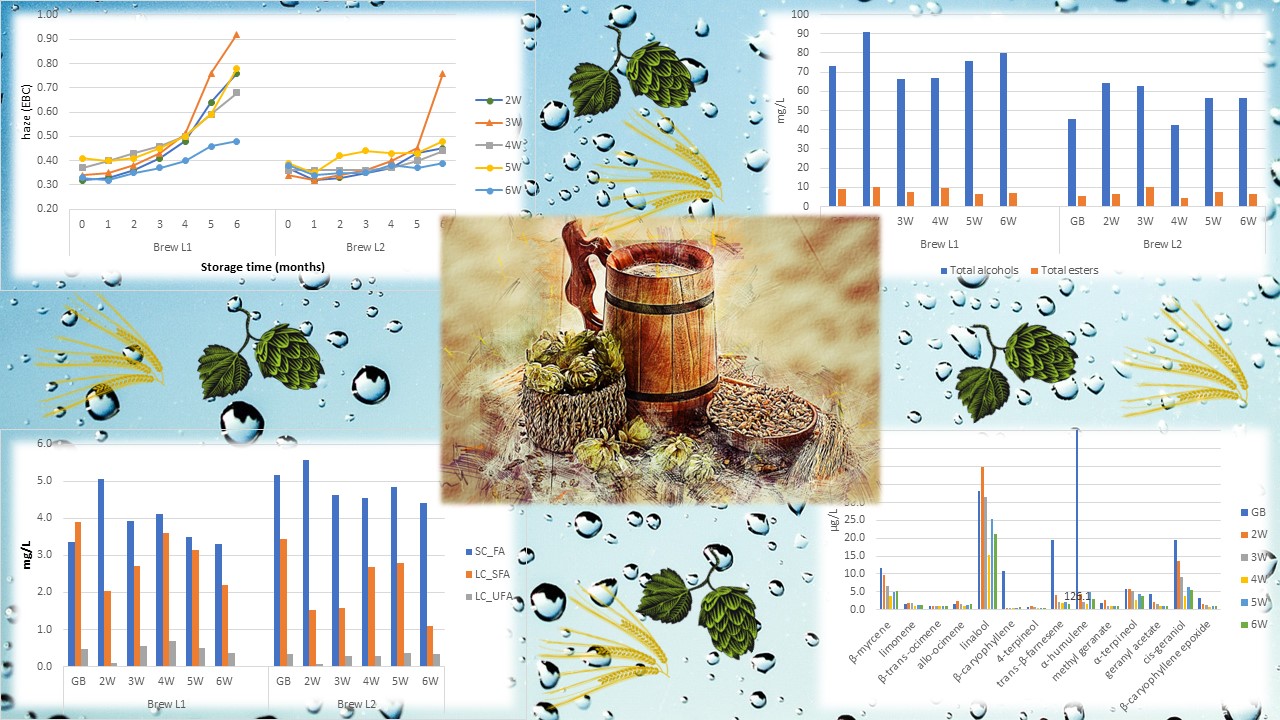How maturation time affects the chemical and sensory profile of pale lager beer
DOI:
https://doi.org/10.18832/kp2023.69.755Keywords:
beer maturation, sensory quality, volatile compounds, essential oils, fatty acids, pale lagerAbstract
The maturation of beer is an important production step with an impact on its quality. Changes in the chemical and sensory profile between 2 and 6 weeks of cold maturation were evaluated in pilot brews (200 l) of a pale lager of 11% and 15% original gravity. In addition to the basic analytical parameters and shelf life, volatiles, hop essential oils, fatty acids, amino acids and stale flavour aldehydes were monitored. The sensory quality of the beers was evaluated using descriptive method. The dynamics of changes in the monitored groups of analytes during maturation of the tested variants was different, but without substantial influence on the overall impression and shelf life of the beer. Under the experimental conditions, it was possible to reduce the maturation time of a common Czech-style lager to 2 weeks of cold lagering. The gradual slight improvement in the overall impression of beers brewed at original gravity indicates the need for a long maturation period to fine-tune the sensory profile of premium lagers. A short maturation period of 2 weeks appears to be beneficial for beers brewed using a high gravity brewing protocol. The findings obtained can be a useful guide for optimising the maturation of Czech-style lager in practice, although the dynamics of changes in the monitored substances and their influence on the sensory characteristics of the beer may be to some degree different when scaled up to operational practice.
References
Analytica EBC (2010). European Brewery Convention, Carl-Hans Verlag, Nürenberg.
Baert, J. J., De Clippeleer, J., Hughes, P. S., De Cooman, L., Aerts, G. (2012). On the origin of free and bound staling aldehydes in beer. Journal of Agricultural and Food Chemistry, 60(46), 11449−11472. https://doi.org/10.1021/jf303670z
Basařová, G., Šavel, J., Basař, P., Lejsek, T. (2017). The comprehensive guide to brewing. Fachverlag Hans Carl, Nürenberg. ISBN 978-3418008424
Bustillo Trueba, P., Jaskula-Goiris, B., Ditrych, M., Filipowska, W., De Brabanter, J., De Rouck, G., Aerts, G., De Cooman, L., De Clippeleer, J. (2021). Monitoring the evolution of free and cysteinylated aldehydes from malt to fresh and forced aged beer. Food Research International, 140, 110049. https://doi.org/10.1016/j.foodres.2020.110049
Commission (2008). Publication of an application pursuant to Article 6(2) of Council Regulation (EC) No 510/2006 on the protection of geographical indications and designations of origin for agricultural products and foodstuffs. Official Journal of the EU C016/05, 23/01/2008, 0014–0022. Available from: https://eur-lex.europa.eu/legal-content/EN/TXT/?uri=OJ:C:2008:016:TOC
Čejka, P., Čulík, J., Horák, T., Jurková, M., Olšovská, J. (2013). Use of chemical indicators of beer aging for ex-post checking of storage conditions and prediction of the sensory stability of beer. Journal of Agricultural and Food Chemistry, 61(51), 12670–12675. https://doi.org/10.1021/jf403361h
Dack, R. E., Black, G. W., Koutsidis, G., Usher, St. J. (2017). The effect of Maillard reaction products and yeast strain on the synthesis of key higher alcohols and esters in beer fermentations. Food Chemistry, 232, 595–561. https://doi.org/10.1016/j.foodchem.2017.04.043
Esslinger, H. M. (2009). Handbook of Brewing. Wiley-VCH, Weinheim. ISBN 978-3-527-31674-8 Handbook of Brewing | Wiley Online Books
Haslbeck, K., Bub, S., Schoenberger, C., Zarnkow, M., Jacob, F., Coelhan, M. (2017). On the fate of beta-myrcene during fermentation – The Role of stripping and uptake of hop oil components by brewer's yeast in dry-hopped wort and beer. Brewing Science, 70(11–12), 159–169. https://doi.org/10.23763/BrSc17-16haslbeck
Horák, T., Čulík, J., Jurková, M., Čejka, P., Olšovská, J. (2013). Determination of fatty acids in beer by a rapid, routine method. Kvasny Prumysl, 59(3), 58–62. https://doi.org/10.18832/kp2013006
Kabelova, I., Dvorakova, M., Cizkova, H., Dostalek, P., Melzoch, K. (2008). Determination of free amino acids in beers: A comparison of Czech and foreign brands. Journal of Food Composition and Analysis, 21(8), 736–741. https://doi.org/10.1016/j.jfca.2008.06.007
MEBAK (2013). Collection of Brewing Analysis Methods of the Mitteleuropäische Brautechnische Analysenkommission. Wort, Beer, Beer-based beverages, Nürenberg, Fachverlag Hans Carl. ISBN 978-3-9805814-7-9
Mikyška, A., Olšovská, J., Slabý, M., Čejka, P., Krofta, K., Pavlovic, M. (2015). A new approach to senzory evaluation of beer bitterness. Belgian brewing conference Chair J. de Clerck XV. Leuven, Belgium.
Mikyška, A., Olšovská, J., Slabý, M., Štěrba, K., Čerenak, A., Košir, I. J., Pavlovič, M., Kolenc, Z., Krofta, K. (2018). Analytical and sensory profiles of Slovenian and Czech hop genotypes in single hopped beers. Journal of the Institute of Brewing, 124(3), 209–229. https://doi.org/10.1002/jib.494
Moll, M. (1994). Beer & Coolers, English ed. Andover Hampshire, Intercept LTD. ISBN 1-898 298-2
Praet, T., Van Opstaele, F., De Causmaecker, B., Aerts, G., De Cooman, L. (2016). Heat-induced changes in the composition of varietal hop essential oils via wort boiling on a laboratory scale. Journal of the American Society of Brewing Chemists, 74(3), 212–223. https://doi.org/10.1094/ASBCJ-2016-3257-01
Praet, T., Van Opstaele, F., Jaskula-Goiris, B., Aerts G., De Cooman, L. (2012). Biotransformations of hop-derived aroma compounds by Saccharomyces cerevisiae upon fermentation. Cerevisia, 36(4), 125–132. https://doi.org/10.1016/j.cervis.2011.12.005
Rettberg N., Martin Biendl, M., Garbe, L-A. (2018). Hop aroma and hoppy beer flavor: Chemical backgrounds and analytical tools—a review. Journal of the American Society of Brewing Chemists, 76(1), 1–20. https://doi.org/10.1080/03610470.2017.1402574
Saison, D., De Schutter, D. P., Vanbeneden, N., Daenen, L., Delvaux, F., Delvaux, F. R. (2010). Decrease of aged beer aroma by the reducing aktivity of brewing yeast. Journal of Agricultural and Food Chemistry, 58(5), 3107–3115. https://doi.org/10.1021/jf9037387
Steiner, E., Becker, T., Gastl, M. (2010). Turbidity and haze formation in beer –insights and overview. Journal of the Institute of Brewing, 116(4), 360–368. https://doi.org/10.1002/j.2050-0416.2010.tb00787.x
Takoi, K., Itoga, Y., Koie, K., Takayanagi, J., Kaneko, T., Watanabe, T., Matsumoto, I., Nomura, M. (2017). Systematic analysis of behaviour of hop-derived monoterpene alcohols during fermentation and new classification of geraniol-rich flavour hops. Brewing Science, 70(11/12), 177–186. https://doi.org/10.23763/BrSc17-17takoi
Vanderhaegen, B., Neven, H., Verachtert, H., Derdelinckx, G. (2006). The chemistry of beer ageing – a critical review. Food Chemistry, 95(3), 357–381. https://doi.org/10.1016/j.foodchem.2005.01.006

Downloads
Published
How to Cite
Issue
Section
License
Copyright (c) 2023 Alexandr Mikyška, Karel Štěrba, Tomáš Horák

This work is licensed under a Creative Commons Attribution 4.0 International License.







